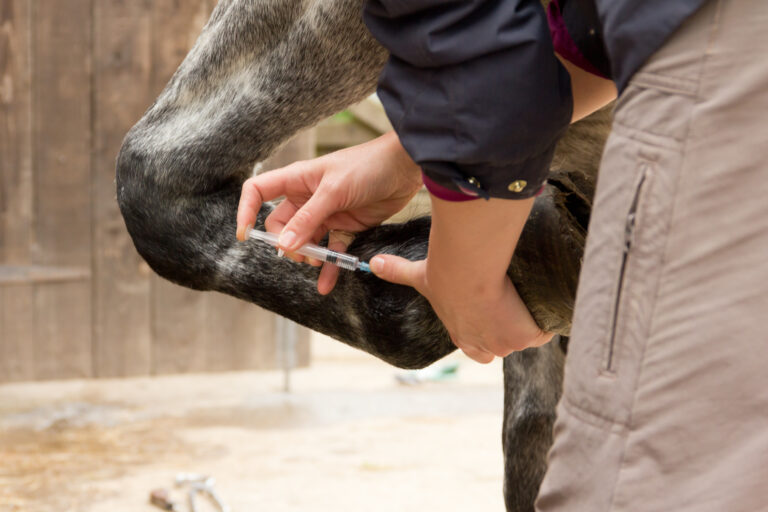This article originally appeared in the Spring 2025 issue of EquiManagement. Sign up here for a FREE subscription to EquiManagement’s quarterly digital or print magazine and any special issues.

Horse owners commonly have to transport their horses to a veterinary clinic for diagnostic testing for endocrine disorders. Most studies about transport’s effects on horses’ endocrine responses focus on long-distance transport. Here, we’ll recap studies examining the stress responses of cortisol, insulin, and adrenocorticotropic hormone (ACTH) in horses transported less than three hours to determine whether short-distance travel might affect lab results for equine endocrine testing and diagnosis of pituitary pars intermedia dysfunction (PPID) or insulin dysregulation (ID).
Effects of Transport on Insulin Concentrations of Aged versus Young Horses
This study compared serum cortisol to salivary cortisol as a biomarker as well as the differences between aged and young horse responses to road trips lasting less than three hours. Erica Jacquay, MS, PhD, reported on the study as part of her PhD thesis during a July 2024 Gluck Equine Research Center webinar.
Based on responses from surveyed horse owners, Jacquay determined that about 30% of horses transported short distances are older than 15. Her team’s study included six young and five senior mares transported 80 minutes. The horses were screened for endocrine disorders a week prior and were negative for PPID and ID. The researchers measured serum cortisol, plasma ACTH, serum insulin, and salivary cortisol at various intervals before, during, and following transport. In all aged horses at three hours post-transport—even those screened as metabolically normal—serum insulin exceeded the basal diagnostic reference range for ID.
Jacquay concluded that aged horses have greater insulin increases one to three hours post-transport compared with young horses; this can influence interpretation of insulin response testing following transportation of aged horses. ACTH remained elevated above the autumn reference range for PPID in three of five aged horses 15 minutes following transport; their ACTH concentrations were higher than those of young horses. Serum and salivary cortisol concentrations, which elevated in response to transport stress, did not yield age-related differences.
In summary, even metabolically normal, aged horses had an increased insulin response to transport. By 24 hours, insulin returned to baseline levels.
Effects of Transport on ID and non-ID Horses
Another study compared short-term transport’s effects on insulin responses in horses with and without ID. Fourteen nonpregnant mares without PPID were separated into two groups: ID or non-ID horses. They were transported for 1.5 hours, with blood and saliva collected at intervals before and after transport. An oral sugar test (OST) was done 24 hours prior to and three hours after transport.
Serum insulin concentrations were higher in the ID horses than the non-ID horses both pre-transportation and post-OST testing (time 0 and 60 minutes). The ID horses’ OST tests elicited high elevations (a twofold increase) of mean serum insulin (154.6 uU/ml). The mean serum insulin concentrations of five of seven non-ID horses was 56.6 uU/ml—also exceeding the insulin concentration threshold for ID diagnosis of 45 uU/ml.
The authors concluded, “Performing dynamic endocrine testing, such as an OST post-transportation, could potentially result in misleading ID status categorization in non-ID horses.”
Effects of Transport on PPID and non-PPID Horses
Jacquay et al. also evaluated PPID and non-PPID horses’ stress responses to short-duration transport. Horses were grouped by PPID status following thyrotropin releasing hormone (TRH) stimulation testing correlated with signs of clinical disease. The study included six non-PPID horses and six PPID horses. The PPID horses had higher ACTH concentrations than non-PPID horses at unloading and 30 minutes later.
But notably, two of the six non-PPID horses had plasma ACTH exceeding the diagnostic threshold for PPID (> 40 pg/ml) at unloading. The authors reported, “ACTH remained elevated in PPID horses following transportation; however, transportation increased cortisol in moderately PPID and non-PPID horses but remained low in severely PPID horses, possibly due to adrenal exhaustion from chronically high ACTH concentrations.”
In the 30 minutes after unloading, some non-PPID horses could be inaccurately diagnosed with PPID because their ACTH concentrations remain elevated above the diagnostic cutoff for PPID. TRH stimulation testing following short-distance transport more accurately screens and identifies non-PPID individuals.
Testing for ID and PPID should be performed cautiously in transported horses. Veterinarians should wait at least 30 minutes following transport to test basal ACTH; otherwise, it’s better to use TRH-stimulation testing to eliminate the risk of false positive results in non-PPID horses while more accurately confirming results in PPID horses.
Take-Home Message
These study results demonstrate that short-distance transport can alter equine endocrine responses depending on horse age and immune function. While transport affects insulin, cortisol, and ACTH values, elevations return to baseline by 24 hours.
Monitor vital signs of senior horses and those with endocrine disorders due to their risk of metabolic concerns and laminitis related to serum insulin increases following transport, even for short distances.
References
- Jacquay ET, Harris PA, Adams AA. Age-Related Differences in Short-Term Transportation Stress Responses of Horses. Journal of Equine Veterinary Science 2023, vol. 128; DOI: 10.1016/j.jevs.2023.104879
- Jacquay ET, Harris P, Adams A. The impact of short-term transportation stress on insulin and oral sugar responses in insulin-dysregulated and non-insulin dysregulated horses. Equine Veterinary Journal Sept 2024; DOI: 10.1111/evj.14403
- Jacquay, Erica, “Impact of Short-Distance Road Transportation on Horse Health” (2024). Theses and Dissertations–Veterinary Science. 66.
Related Reading
- Equine Endocrinopathies: Is it ID, PPID, or Both?
- Impact of Transportation on ID Testing in Horses
- Diagnosing and Managing EMS Cases
Stay in the know! Sign up for EquiManagement’s FREE weekly newsletters to get the latest equine research, disease alerts, and vet practice updates delivered straight to your inbox.




